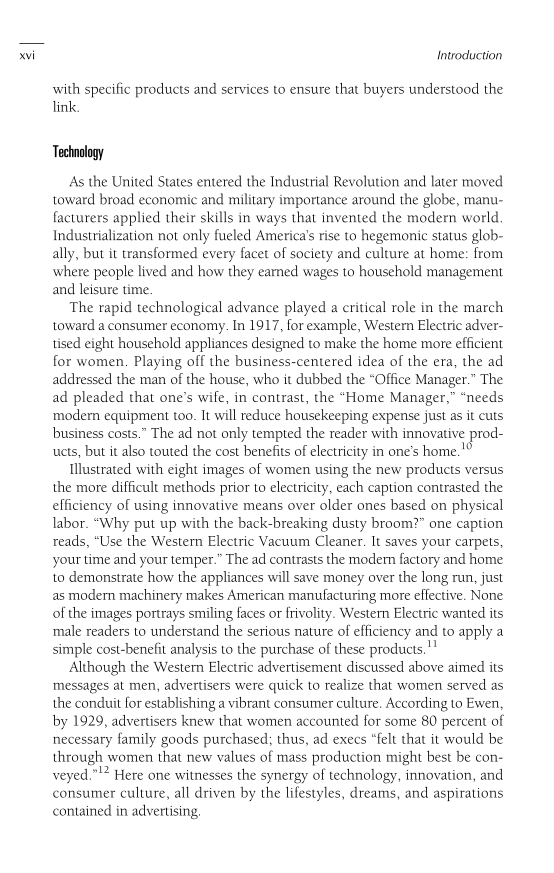xvi Introduction with specific products and services to ensure that buyers understood the link. Technology As the United States entered the Industrial Revolution and later moved toward broad economic and military importance around the globe, manu- facturers applied their skills in ways that invented the modern world. Industrialization not only fueled America’s rise to hegemonic status glob- ally, but it transformed every facet of society and culture at home: from where people lived and how they earned wages to household management and leisure time. The rapid technological advance played a critical role in the march toward a consumer economy. In 1917, for example, Western Electric adver- tised eight household appliances designed to make the home more efficient for women. Playing off the business-centered idea of the era, the ad addressed the man of the house, who it dubbed the “Office Manager.” The ad pleaded that one’s wife, in contrast, the “Home Manager,” “needs modern equipment too. It will reduce housekeeping expense just as it cuts business costs.” The ad not only tempted the reader with innovative prod- ucts, but it also touted the cost benefits of electricity in one’s home.10 Illustrated with eight images of women using the new products versus the more difficult methods prior to electricity, each caption contrasted the efficiency of using innovative means over older ones based on physical labor. “Why put up with the back-breaking dusty broom?” one caption reads, “Use the Western Electric Vacuum Cleaner. It saves your carpets, your time and your temper.” The ad contrasts the modern factory and home to demonstrate how the appliances will save money over the long run, just as modern machinery makes American manufacturing more effective. None of the images portrays smiling faces or frivolity. Western Electric wanted its male readers to understand the serious nature of efficiency and to apply a simple cost-benefit analysis to the purchase of these products.11 Although the Western Electric advertisement discussed above aimed its messages at men, advertisers were quick to realize that women served as the conduit for establishing a vibrant consumer culture. According to Ewen, by 1929, advertisers knew that women accounted for some 80 percent of necessary family goods purchased thus, ad execs “felt that it would be through women that new values of mass production might best be con- veyed.”12 Here one witnesses the synergy of technology, innovation, and consumer culture, all driven by the lifestyles, dreams, and aspirations contained in advertising.
Document Details My Account Print multiple pages
Print
You have printed 0 times in the last 24 hours.
Your print count will reset on at .
You may print 0 more time(s) before then.
You may print a maximum of 0 pages at a time.



















































































































































































































































































































































































































































































































































































































































































































































































































































































































































































































































































































